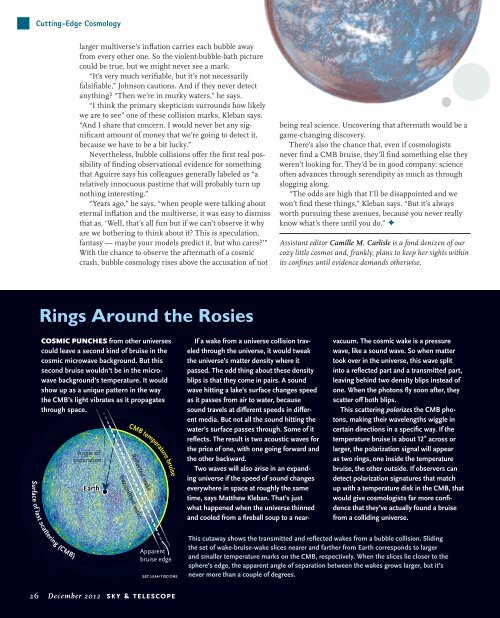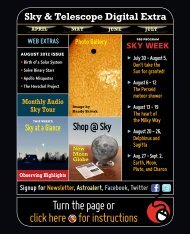Sky & Telescope Magazine December 2012 - TuLaTri.com
Sky & Telescope Magazine December 2012 - TuLaTri.com
Sky & Telescope Magazine December 2012 - TuLaTri.com
Create successful ePaper yourself
Turn your PDF publications into a flip-book with our unique Google optimized e-Paper software.
Cutting-Edge Cosmology<br />
Surface of last scattering (CMB)<br />
larger multiverse’s infl ation carries each bubble away<br />
from every other one. So the violent-bubble-bath picture re<br />
could be true, but we might never see a mark.<br />
“It’s very much verifi able, but it’s not necessarily<br />
falsifi able,” Johnson cautions. And if they never detect<br />
anything? “Then we’re in murky waters,” he says.<br />
“I think the primary skepticism surrounds how likely ely<br />
we are to see” one of these collision marks, Kleban says. s.<br />
“And I share that concern. I would never bet any signifi<br />
cant amount of money that we’re going to detect it,<br />
because we have to be a bit lucky.”<br />
Nevertheless, bubble collisions off er the fi rst real possibility<br />
of fi nding observational evidence for something<br />
that Aguirre says his colleagues generally labeled as “a<br />
relatively innocuous pastime that will probably turn up<br />
nothing interesting.”<br />
“Years ago,” he says, “when people were talking about<br />
eternal infl ation and the multiverse, it was easy to dismiss<br />
that as, ‘Well, that’s all fun but if we can’t observe it why<br />
are we bothering to think about it? This is speculation,<br />
fantasy — maybe your models predict it, but who cares?’”<br />
With the chance to observe the aftermath of a cosmic<br />
crash, bubble cosmology rises above the accusation of not<br />
Rings Around the Rosies<br />
COSMIC PUNCHES from other universes<br />
could leave a second kind of bruise in the<br />
cosmic microwave background. But this<br />
second bruise wouldn’t be in the microwave<br />
background’s temperature. It would<br />
show up as a unique pattern in the way<br />
the CMB’s light vibrates as it propagates<br />
through space.<br />
Ang Angle AAng AAn Angle An Angl A AAn Ang n ng n g ggl<br />
gle g ggl g l lle l le l e of o of o of o of o f<br />
separation se sse separation sse s se s sepa ep eepa e ep e eepa p ppa<br />
p ppaar a aar aar a r rratio ra r ra at a aati<br />
t tti tti<br />
t tti<br />
tio o on n<br />
Earth<br />
Ea EEarth a rt r t tthh<br />
Reflected Reflected RRRRRRRRe Re Refl Reflected RRRefl RRe RRe Re Re Refl Refle Re Re Refl Refle Reefle<br />
efle eflec eflflec fle flec fle fle flec ec ec ec ec ect ect ecte ect ected ct ct cte cted cte<br />
te te tedd ted te ted ted te ed edddddwwwwwww ed ed edddw ed ed ed ed eddd dddwake dwwak d wake wake wak ww wa wake wwa wwa wwa wa wa wa wwak wakke<br />
aak ak ake ak ak ake akk kke<br />
ke ke kkkke ke k<br />
Transmitted Transmitted TTTTTTTr TTra Transmitted TTTr Tr Tr TTr Tr TTTra Tra Tr Traa Tr Tra Tr Tran TTra raaaan raansssm an an an ans ans ansmit ann nsmmit nsm nnssmi<br />
ns nsmit ssmmii sm sssm smitted smit mmiit mi mitte mmi mit mit mit it it itt itttt iit<br />
ttte tt tted tted teed ted tted<br />
te ted te te te ted ed ed ed edd<br />
d dd dd<br />
wake wake wak wwa<br />
waakkke ww<br />
wwak<br />
wa wak wa ww<br />
wake wake ww<br />
ake aaaake akke<br />
ke ke ke ke ke kk<br />
ke ke ke kkkkke ke ke<br />
CMB temperature bruise<br />
Apparent<br />
bruise edge<br />
S&T: LEAH TISCIONE<br />
26 <strong>December</strong> <strong>2012</strong> sky & telescope<br />
If a wake from a universe collision traveled<br />
through the universe, it would tweak<br />
the universe’s matter density where it<br />
passed. The odd thing about these density<br />
blips is that they <strong>com</strong>e in pairs. A sound<br />
wave hitting a lake’s surface changes speed<br />
as it passes from air to water, because<br />
sound travels at diff erent speeds in diff erent<br />
media. But not all the sound hitting the<br />
water’s surface passes through. Some of it<br />
refl ects. The result is two acoustic waves for<br />
the price of one, with one going forward and<br />
the other backward.<br />
Two waves will also arise in an expanding<br />
universe if the speed of sound changes<br />
everywhere in space at roughly the same<br />
time, says Matthew Kleban. That’s just<br />
what happened when the universe thinned<br />
and cooled from a fi reball soup to a near-<br />
being real science. Uncovering that aftermath would be a<br />
game-changing discovery.<br />
There’s also the chance that, even if cosmologists<br />
never fi nd a CMB bruise, they’ll fi nd something else they<br />
weren’t looking for. They’d be in good <strong>com</strong>pany: science<br />
often advances through serendipity as much as through<br />
slogging along.<br />
“The odds are high that I’ll be disappointed and we<br />
won’t fi nd these things,” Kleban says. “But it’s always<br />
worth pursuing these avenues, because you never really<br />
know what’s there until you do.” ✦<br />
Assistant editor Camille M. Carlisle is a fond denizen of our<br />
cozy little cosmos and, frankly, plans to keep her sights within<br />
its confi nes until evidence demands otherwise.<br />
vacuum. The cosmic wake is a pressure<br />
wave, like a sound wave. So when matter<br />
took over in the universe, this wave split<br />
into a refl ected part and a transmitted part,<br />
leaving behind two density blips instead of<br />
one. When the photons fl y soon after, they<br />
scatter off both blips.<br />
This scattering polarizes the CMB photons,<br />
making their wavelengths wiggle in<br />
certain directions in a specifi c way. If the<br />
temperature bruise is about 12° across or<br />
larger, the polarization signal will appear<br />
as two rings, one inside the temperature<br />
bruise, the other outside. If observers can<br />
detect polarization signatures that match<br />
up with a temperature disk in the CMB, that<br />
would give cosmologists far more confi -<br />
dence that they’ve actually found a bruise<br />
from a colliding universe.<br />
This cutaway shows the transmitted and refl ected wakes from a bubble collision. Sliding<br />
the set of wake-bruise-wake slices nearer and farther from Earth corresponds to larger<br />
and smaller temperature marks on the CMB, respectively. When the slices lie closer to the<br />
sphere’s edge, the apparent angle of separation between the wakes grows larger, but it’s<br />
never more than a couple of degrees.



